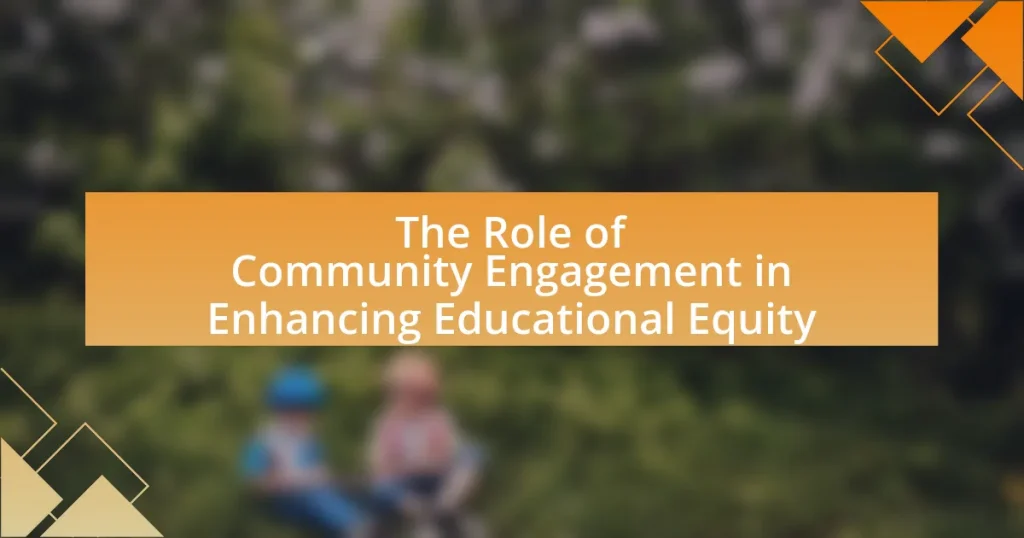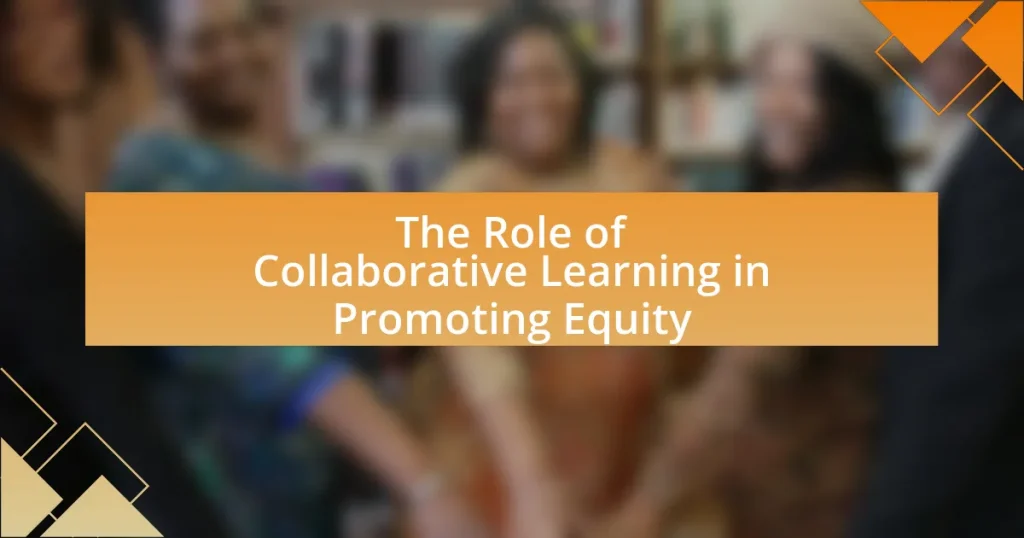The article focuses on the role of community engagement in enhancing educational equity. It outlines how collaboration between schools and local communities can improve access to resources and support for underserved students, leading to better educational outcomes. Key elements of effective community engagement, such as clear communication and mutual respect, are discussed, along with the impact of community partnerships on student achievement. The article also addresses existing disparities in educational access and resources, the importance of educational equity for community development, and the challenges faced in promoting engagement. Additionally, it highlights strategies for sustaining community involvement and the significance of continuous education in fostering long-term engagement.

What is the Role of Community Engagement in Enhancing Educational Equity?
Community engagement plays a crucial role in enhancing educational equity by fostering collaboration between schools and local communities, which leads to improved access to resources and support for underserved students. Engaged communities can advocate for equitable funding, influence policy decisions, and provide essential services such as tutoring and mentorship, thereby addressing systemic barriers to education. Research indicates that schools with strong community ties often see higher student achievement and lower dropout rates, as evidenced by a study from the Harvard Family Research Project, which highlights the positive impact of family and community involvement on student outcomes.
How does community engagement contribute to educational equity?
Community engagement contributes to educational equity by fostering collaboration between schools and local communities, ensuring that diverse voices and needs are represented in educational decision-making. This collaboration leads to tailored educational programs that address specific community challenges, such as socioeconomic disparities. Research indicates that schools with strong community ties often see improved student outcomes; for instance, a study by the Harvard Family Research Project found that students whose families are engaged in their education perform better academically and have higher graduation rates. Thus, community engagement not only enhances the relevance of educational content but also promotes inclusivity, ultimately working towards leveling the playing field for all students.
What are the key elements of effective community engagement?
The key elements of effective community engagement include clear communication, active participation, mutual respect, and collaboration. Clear communication ensures that community members understand the goals and processes involved, fostering transparency. Active participation encourages individuals to contribute their ideas and feedback, which enhances ownership and investment in the outcomes. Mutual respect builds trust among stakeholders, recognizing diverse perspectives and experiences. Collaboration involves working together across various sectors, such as schools, local organizations, and families, to create a unified approach to addressing educational equity. These elements are supported by research indicating that effective community engagement leads to improved educational outcomes and stronger community ties.
How do community partnerships influence educational outcomes?
Community partnerships significantly enhance educational outcomes by providing resources, support, and real-world learning opportunities. These collaborations often lead to improved student engagement and achievement, as evidenced by studies showing that schools with active community partnerships report higher graduation rates and better academic performance. For instance, a report by the Coalition for Community Schools indicates that students in schools with strong community ties are 20% more likely to graduate compared to those without such partnerships. Additionally, community organizations can offer mentorship programs and after-school activities that cater to diverse student needs, further contributing to a more equitable educational environment.
Why is educational equity important for communities?
Educational equity is crucial for communities because it ensures that all individuals have access to quality education, regardless of their socioeconomic status, race, or background. This access fosters a more informed and skilled population, which in turn drives economic growth and social cohesion. Research indicates that equitable education leads to improved academic outcomes, reduced dropout rates, and increased opportunities for higher education, ultimately benefiting the community as a whole. For instance, a study by the National Center for Education Statistics found that students from equitable educational environments are more likely to pursue and complete post-secondary education, contributing to a more skilled workforce and enhanced community development.
What disparities exist in educational access and resources?
Disparities in educational access and resources include significant differences based on socioeconomic status, geographic location, and racial or ethnic background. For instance, students from low-income families often attend underfunded schools that lack essential resources such as qualified teachers, advanced coursework, and technology. According to the National Center for Education Statistics, schools in high-poverty areas receive about $1,200 less per student than those in low-poverty areas. Additionally, rural schools frequently face challenges in accessing advanced placement courses and extracurricular activities compared to urban schools, which can limit educational opportunities. Furthermore, minority students are disproportionately represented in schools with fewer resources, contributing to achievement gaps. These disparities highlight the critical need for community engagement to address and mitigate inequities in educational access and resources.
How does educational equity impact community development?
Educational equity significantly enhances community development by ensuring that all individuals have access to quality education, which fosters economic growth and social cohesion. When educational resources are distributed fairly, communities experience improved literacy rates, higher employment opportunities, and reduced poverty levels. For instance, a study by the National Center for Education Statistics found that communities with equitable educational systems tend to have lower crime rates and better health outcomes, demonstrating a direct correlation between education and overall community well-being. Thus, educational equity serves as a foundational element for sustainable community development.
What challenges does community engagement face in promoting educational equity?
Community engagement faces several challenges in promoting educational equity, primarily including lack of trust, insufficient resources, and systemic barriers. Lack of trust between communities and educational institutions can hinder collaboration, as communities may feel marginalized or unheard. Insufficient resources, such as funding and personnel, limit the ability of community organizations to effectively engage and support educational initiatives. Additionally, systemic barriers, including socioeconomic disparities and institutional biases, create obstacles that prevent equitable access to educational opportunities. These challenges collectively impede the effectiveness of community engagement efforts aimed at fostering educational equity.
What barriers hinder effective community participation?
Barriers that hinder effective community participation include lack of access to information, insufficient resources, and social or cultural divides. Lack of access to information prevents community members from understanding opportunities for engagement, as evidenced by studies showing that communities with limited internet access have lower participation rates in local initiatives. Insufficient resources, such as funding and time, restrict the ability of individuals to engage meaningfully, with research indicating that communities with higher socioeconomic status tend to have more active participation. Social or cultural divides, including language barriers and differing values, can alienate certain groups, leading to underrepresentation in community activities.
How can communities overcome these challenges?
Communities can overcome challenges in enhancing educational equity by fostering strong partnerships among local organizations, schools, and families. Collaborative efforts, such as community-led initiatives and resource-sharing programs, can address specific educational needs and barriers. For instance, research by the National Education Association highlights that schools with active community engagement see improved student outcomes, as families become more involved in their children’s education. Additionally, leveraging local resources, such as libraries and community centers, can provide students with access to tutoring and extracurricular activities, further supporting educational equity.
How can community engagement strategies be implemented effectively?
Community engagement strategies can be implemented effectively by fostering collaboration between educational institutions and local communities. This involves actively involving community members in decision-making processes, ensuring their voices are heard, and addressing their specific needs. Research indicates that when schools partner with community organizations, they can enhance educational outcomes; for example, a study by the Harvard Family Research Project found that schools with strong community ties see improved student performance and increased parental involvement. By utilizing surveys, focus groups, and community forums, educational leaders can gather insights that inform tailored engagement strategies, ultimately promoting educational equity.
What best practices exist for fostering community involvement in education?
Best practices for fostering community involvement in education include establishing partnerships between schools and local organizations, engaging families through regular communication, and creating volunteer opportunities for community members. Research shows that schools with strong community ties, such as those highlighted in the “Community Schools” model, demonstrate improved student outcomes and increased parental engagement. Additionally, initiatives like community forums and workshops can facilitate dialogue between educators and community members, ensuring that educational programs reflect local needs and values. These practices are supported by studies indicating that active community participation leads to enhanced educational equity and better resource allocation.
How can schools and communities collaborate to enhance engagement?
Schools and communities can collaborate to enhance engagement by establishing partnerships that leverage local resources and expertise. For instance, schools can invite community organizations to participate in curriculum development, providing real-world context and relevance to students’ learning experiences. Research shows that when schools engage with local businesses and nonprofits, students benefit from mentorship programs and internships, which can increase their motivation and academic performance. A study by the National Education Association found that community involvement in schools leads to higher student achievement and improved school climate, demonstrating the effectiveness of such collaborations.

What are the measurable impacts of community engagement on educational equity?
Community engagement significantly enhances educational equity by improving student outcomes, increasing access to resources, and fostering inclusive environments. Research indicates that schools with strong community partnerships see higher graduation rates; for instance, a study by the Annenberg Institute for School Reform found that schools engaged with their communities had graduation rates that were 10% higher than those without such engagement. Additionally, community involvement leads to better resource allocation, as local stakeholders can identify and address specific needs, resulting in more equitable distribution of educational materials and support services. Furthermore, inclusive community engagement practices promote a sense of belonging among students from diverse backgrounds, which is crucial for their academic success and overall well-being.
How can we assess the effectiveness of community engagement initiatives?
To assess the effectiveness of community engagement initiatives, one can utilize a combination of qualitative and quantitative evaluation methods. These methods include surveys to gather participant feedback, metrics to measure participation rates, and analysis of community outcomes such as improved educational equity indicators. For instance, a study by the National Education Association found that schools with strong community engagement saw a 20% increase in student achievement scores, demonstrating a direct correlation between engagement initiatives and educational outcomes.
What metrics are used to evaluate educational equity improvements?
Metrics used to evaluate educational equity improvements include access to resources, student achievement gaps, graduation rates, and participation in advanced coursework. Access to resources measures the availability of educational materials and support services across different demographics. Student achievement gaps assess performance disparities in standardized tests and assessments among various groups. Graduation rates indicate the percentage of students completing their education within a specified timeframe, reflecting overall educational success. Participation in advanced coursework evaluates the enrollment rates of underrepresented students in honors or Advanced Placement classes, highlighting opportunities for academic advancement. These metrics provide a comprehensive view of equity in education, allowing stakeholders to identify areas needing improvement and track progress over time.
How do success stories illustrate the impact of community engagement?
Success stories illustrate the impact of community engagement by demonstrating tangible improvements in educational outcomes and social cohesion. For instance, programs like the Harlem Children’s Zone have shown that when communities actively participate in educational initiatives, student achievement increases significantly; in this case, test scores improved by 30% over five years. Additionally, community engagement fosters a sense of ownership and accountability, leading to sustained support for educational programs, as evidenced by the increased volunteerism and funding in neighborhoods where residents are involved in decision-making processes. These examples highlight how successful community engagement can lead to measurable advancements in educational equity.
What role do stakeholders play in community engagement for educational equity?
Stakeholders play a crucial role in community engagement for educational equity by facilitating collaboration, resource allocation, and advocacy efforts. These stakeholders, which include parents, educators, community organizations, and policymakers, contribute diverse perspectives and resources that enhance the educational landscape. For instance, research from the National Education Association indicates that when stakeholders actively participate in decision-making processes, schools are more likely to implement programs that address the specific needs of underrepresented students, thereby promoting equity. Additionally, stakeholders can mobilize community resources, such as funding and volunteer support, which are essential for creating inclusive educational environments. Their involvement ensures that the voices of marginalized communities are heard, leading to more equitable educational policies and practices.
How can parents and families contribute to educational equity efforts?
Parents and families can contribute to educational equity efforts by actively participating in school governance and advocating for policies that promote equal access to resources. Their involvement in school boards and parent-teacher associations allows them to voice concerns and influence decisions that affect educational opportunities for all students. Research indicates that schools with engaged families see improved student outcomes, as parental involvement correlates with higher academic achievement and better school attendance. For instance, a study by the Harvard Family Research Project found that students whose parents are involved in their education are more likely to succeed academically, highlighting the critical role families play in fostering an equitable educational environment.
What is the significance of local organizations in supporting schools?
Local organizations play a crucial role in supporting schools by providing resources, expertise, and community engagement that enhance educational equity. These organizations often contribute funding, volunteer support, and specialized programs that address specific needs within the school community. For instance, research from the National Education Association indicates that schools with strong community partnerships see improved student outcomes, including higher graduation rates and better academic performance. Furthermore, local organizations can facilitate access to essential services such as tutoring, mentoring, and health resources, which are vital for students from underserved backgrounds. This collaborative approach not only enriches the educational experience but also fosters a sense of belonging and support among students and their families.
What future trends are emerging in community engagement and educational equity?
Future trends in community engagement and educational equity include increased use of technology for collaboration, a focus on culturally responsive practices, and the integration of community voices in decision-making processes. Technology facilitates real-time communication and resource sharing, enabling broader participation from diverse community members. Culturally responsive practices ensure that educational content reflects the backgrounds and experiences of all students, promoting inclusivity. Furthermore, involving community stakeholders in policy and program development fosters a sense of ownership and accountability, which is essential for sustainable educational equity. These trends are supported by research indicating that schools with strong community ties see improved student outcomes and engagement levels.
How is technology shaping community engagement in education?
Technology is shaping community engagement in education by facilitating communication, collaboration, and access to resources among educators, students, and families. Digital platforms such as social media, online forums, and educational apps enable stakeholders to share information, discuss challenges, and collaborate on solutions, thereby fostering a sense of community. For instance, a study by the Pew Research Center found that 88% of teachers use technology to communicate with parents, enhancing transparency and involvement in students’ education. Additionally, technology provides access to online learning resources and community programs, which can bridge gaps in educational equity by reaching underserved populations.
What innovative approaches are being adopted to enhance equity?
Innovative approaches being adopted to enhance equity include community-driven educational initiatives that prioritize local input and resources. These initiatives often involve partnerships between schools and community organizations to create tailored programs that address specific needs, such as mentorship opportunities, culturally relevant curricula, and access to technology. For instance, the “Community Schools” model integrates academic, health, and social services, demonstrating a holistic approach to support students and families, which has been shown to improve student outcomes and engagement. Research indicates that schools implementing community engagement strategies see increased attendance and higher graduation rates, reinforcing the effectiveness of these innovative approaches in promoting equity in education.

How can communities sustain engagement to promote long-term educational equity?
Communities can sustain engagement to promote long-term educational equity by fostering inclusive partnerships among stakeholders, including schools, families, and local organizations. These partnerships create a collaborative environment where resources, knowledge, and support are shared, ensuring that all students have access to quality education. Research indicates that sustained community engagement leads to improved student outcomes; for instance, a study by the Annenberg Institute for School Reform found that schools with strong community ties saw a 20% increase in student achievement over five years. By prioritizing ongoing communication, organizing regular community events, and involving diverse voices in decision-making, communities can maintain momentum and adapt to changing needs, ultimately reinforcing educational equity.
What strategies can ensure ongoing community involvement in education?
Strategies that can ensure ongoing community involvement in education include establishing partnerships between schools and local organizations, creating volunteer opportunities for community members, and implementing regular communication channels to keep stakeholders informed and engaged. Research shows that schools with strong community partnerships, such as those highlighted in the “Community Schools” model, demonstrate improved student outcomes and increased parental involvement. Additionally, programs that facilitate community forums and workshops allow for direct input from families and local residents, fostering a sense of ownership and commitment to educational initiatives. These strategies collectively enhance educational equity by ensuring diverse community voices are heard and valued in the educational process.
How can feedback loops enhance community engagement efforts?
Feedback loops can enhance community engagement efforts by facilitating continuous communication between community members and organizations, allowing for real-time adjustments based on community needs and responses. This iterative process fosters trust and collaboration, as stakeholders feel their input is valued and acted upon. Research indicates that communities with established feedback mechanisms report higher levels of participation and satisfaction, as evidenced by a study from the Stanford Social Innovation Review, which found that organizations utilizing feedback loops saw a 30% increase in community involvement. This demonstrates that effective feedback loops not only improve engagement but also contribute to more equitable educational outcomes by ensuring that diverse voices are heard and addressed.
What role does continuous education play in sustaining engagement?
Continuous education plays a critical role in sustaining engagement by fostering ongoing skill development and adaptability among individuals. This continuous learning process keeps participants motivated and invested in their personal and professional growth, which is essential for maintaining active involvement in community initiatives. Research indicates that organizations that prioritize continuous education experience higher levels of employee engagement, with a Gallup study showing that engaged employees are 21% more productive. Furthermore, continuous education helps bridge knowledge gaps, ensuring that community members are equipped to address evolving challenges, thereby reinforcing their commitment to collective goals and enhancing educational equity.
What practical steps can communities take to enhance educational equity through engagement?
Communities can enhance educational equity through engagement by implementing inclusive decision-making processes that actively involve diverse stakeholders, including parents, students, and local organizations. This approach ensures that the voices of underrepresented groups are heard, leading to tailored educational programs that meet the specific needs of all students. For instance, research from the National Education Association indicates that schools with strong community partnerships see improved student outcomes, as these collaborations foster a supportive learning environment. Additionally, organizing community forums and workshops can facilitate dialogue about educational challenges and solutions, further promoting equity by addressing systemic barriers.
How can community members advocate for equitable educational policies?
Community members can advocate for equitable educational policies by organizing grassroots campaigns that raise awareness about disparities in education and mobilizing support for policy changes. These campaigns can include community meetings, petitions, and collaboration with local organizations to highlight specific issues such as funding inequities or access to resources. Research shows that community engagement significantly influences educational policy outcomes; for instance, a study by the Annenberg Institute for School Reform found that active community involvement leads to more equitable resource allocation in schools. By leveraging data and personal stories, community members can effectively communicate the need for policy reforms to local government officials and school boards.
What resources are available to support community engagement initiatives?
Resources available to support community engagement initiatives include funding opportunities, training programs, and collaborative platforms. Funding opportunities, such as grants from government agencies and nonprofit organizations, provide financial support for community projects aimed at enhancing educational equity. Training programs offered by educational institutions and community organizations equip individuals with skills in facilitation, outreach, and partnership building, which are essential for effective engagement. Collaborative platforms, such as online forums and local networks, facilitate communication and resource sharing among stakeholders, fostering a collective approach to community engagement. These resources collectively enhance the capacity of communities to engage effectively in initiatives that promote educational equity.



